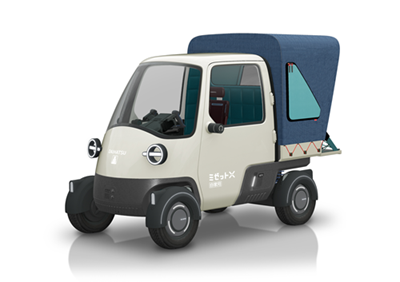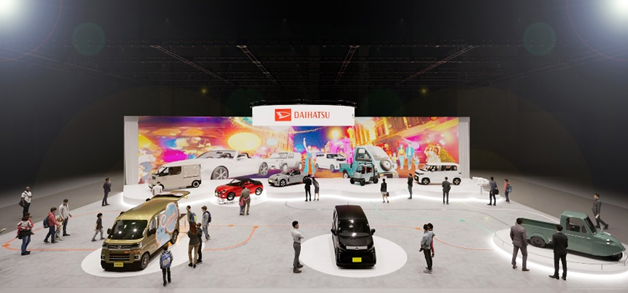- Products / Technology
- Vehicle
- NEWApr. 12, 2016
Daihatsu Boon Compact Car Undergoes Complete Model Change Compact Cars Make Significant Progress with the Know-How Built Up in the Area of Mini Vehicle - New Boon Achieves No.1 Fuel Efficiency for a Gasoline Vehicle*1, Affordable Price, and Improved Basic Performance -
Apr. 12, 2016
Daihatsu Motor Co., Ltd.
 Boon X“G package SA Ⅱ”
Boon X“G package SA Ⅱ”
 Boon CILQ “G package SA Ⅱ”
Boon CILQ “G package SA Ⅱ”
Daihatsu Motor Co., Ltd. (“Daihatsu”) announces that it is launching the fully redesigned Boon compact car simultaneously nationwide on Tuesday, April 12, 2016.
In light of the growing demand for compact cars in the market, Daihatsu has remodeled the Boon by introducing its strengths built up in the field of mini vehicles (technology developed for mini vehicles and life-oriented product proposals tailored to user needs) to compact cars, which aims to improve the overall level of compact cars centered on mini vehicles.
With the adoption of the “e:S Technology” developed for mini vehicles, the new Boon achieves the highest fuel efficiency in the gasoline engine registered vehicle, as well as affordable prices. To attain further product competitiveness, Daihatsu visited actual customers to find out their needs,
which has resulted in the introduction of a lightweight high-rigidity body for the significantly improved platform that increases the interior size and enhances the basic performance while maintaining maneuverability. In addition, it also incorporates an efficient packaging technology developed for mini vehicles, which expands the interior space, embodies a design with a sense of security / stability, and evolves basic performance, all at the same time.
Furthermore, with this complete model change, Daihatsu introduces to compact cars the 2 Face Strategy, its favorite fort in mini vehicles, creating the new higher-grade “Boon CILQ*2.”
The new Boon offers the following features:
1. Fuel efficiency of 28.0 km/L*3, the highest level in the gasoline engine registered vehicle, and an affordable price
2. Combination of an easy-to-maneuver compact body and the most spacious interior in the class*4
3. Improved basic performance that provides a high quality, flat ride in the city
4. Two accessible and stylish designs
*1: As of April 12, 2016, based on research conducted by Daihatsu, except for mild hybrids, hybrids, and plug-in hybrids
*2: CILQ stands for “Compact, Impressive, Lovely, and Quality."
*3: 2WD vehicle, JC08 mode fuel efficiency, the inspection value of the Ministry of Land, Infrastructure, Transport and Tourism
*4: As of April 12, 2016, based on research conducted by Daihatsu, the comparison of an interior capacity rate with a 2 box compact registered car but with a total height of 1,600 mm or less Interior capacity rate = Interior volume (interior length × interior width × interior height) ÷ Vehicle volume (total length x total width x total height)
Vehicle Outline
1. No. 1 Fuel Efficiency in the gasoline engine registered vehicle, and an Affordable Price
◇ Adoption of the “e:S Technology” achieves fuel efficiency of 28.0 km/L*5, which is eligible for the eco-car tax break.
< Power Train Evolution >
- Powered by the 1-litre 1KR-FE engine
- The adoption of a dual intake port set improves the tumble motion and the intake efficiency.
- A dual injector allows the injection port to be closer to the combustion chamber, which results in greater combustion efficiency.
- A higher compression ratio (from the previous level of 11.5 to 12.5) is achieved by the improved tumble motion, the adoption of the Atkinson cycle technology, and the optimized piston shape.
- The improved responsiveness of EGR valves expands the EGR amount, which results in greater combustion efficiency.
< Vehicle Evolution >
- The improved aerodynamic performance (aerodynamic design, adoption of aerodynamic parts) reduces the Cd value.
< Energy Management Evolution >
- The 4WD vehicles adopt the “eco IDLE” system, which controls the idle-stop when it slows to below 9 km/h, achieving higher fuel efficiency of 24.4 km/L*6 , which allows all the models to be eligible for the eco-car tax break.
◇ The compact cars take over the efforts of the cost reduction activities in the realm of component materials and parts and procurement reform undertaken in the field of mini vehicles.
- Just as it has done in the field of mini vehicles, Daihatsu continues its efforts in terms of cost reduction activities in the realm of component materials and parts and procurement reform in the development of compact cars. The cost reduction efforts involved activities that went beyond the boundaries of functions, including the design development that reflected on design quality and the component design that was based on production requirements. These endeavors aimed at a more qualified design from the perspectives of whether the structure was theoretically correct, whether the potential of the materials was fully tapped, and whether it was possible to lower the production costs by figuring out better methods of design and production.
- Daihatsu pursued the most qualified design plan in terms of quality and cost by undertaking a thorough review of the arrangement, shape, and material selection of the parts, and successfully lowered the costs by cutting down the number of components and the vehicle weight.
- After it reduced the production costs with its improved design quality, Daihatsu also pursued product strength that aligns with the product properties, enhancing product competitiveness while achieving an entry price of around 1,150,000 yen*7.
2. Combination of an Easy-to-Maneuver Compact Body and the Most Spacious Interior in the Class
◇ The highly efficient package achieves a spacious interior.
- It keeps the compact body, which is easy to maneuver even for inexperienced drivers, with the total length/width unchanged, while it enlarges the wheel base and moves the rear seat back to increase the distance between the front and rear passengers by 75 mm from the previous model to 940 mm, achieving the most spacious interior in the class*8.
- The wider tread optimizes the steering angle of the front wheels to attain a minimum turning radius of 4.6 m, achieving better maneuverability than the previous model.
*5: 2WD vehicle, JC08 mode fuel efficiency, inspection value of the Ministry of Land, Infrastructure, Transport and Tourism
*6: 4WD vehicle, JC08 mode fuel efficiency, inspection value of the Ministry of Land, Infrastructure, Transport and Tourism
*7: Grade X 2WD vehicle, the price is the suggested retail price (including consumption tax)
*8: As of April 12, 2016, based on research conducted by Daihatsu, the class of a 2 box compact car larger than a light motor vehicle but with a total height of 1,600 mm or less
3. Improved Basic Performance that Provides a High Quality, Flat Ride in the City
Adoption of a lightweight high-rigidity body significantly improves the platform to enhance basic performance.
◇ The adoption of a lightweight high-rigidity body called the “D Monocoque” improves the basic performance while maintaining the vehicle weight.
- The lightweight, high-rigidity body structure is a structure in which thick, high tensile steel sheets are applied to all side outer panels to reduce the number of structural breakpoints and absorb impact across the entire frame. Resinifying the outer panels and other tactics reduces the entire body weight by 50 kg, while the body ensures collision safety performance that is equivalent to that of the previous model. Moreover, the optimum reinforcement of the underbody offers increased rigidity to improve the basic performance.
- The adoption of high tensile steel sheets on all side outer panels, instead of placing reinforcing materials between the outer and inner panels, produces a stronger and lighter body at the same time.
- The optimum reinforcement to the underbody for improved steering performance and rear tire adhesion offers increased rigidity to significantly enhance driving performance.
◇ The resin technology developed in the field of mini vehicles is applied to compact cars, contributing to weight reduction.
- Daihatsu assesses the requirements of each part to select the right material for the right place. Applying resin outer panels to new spoiler-integrated back doors, front fenders and the fuel lid contributes to weight reduction.
- The resin fuel tank has a structure that equalizes the wall thickness for weight reduction and adopts a diamond bead shape for rigidity and shock absorption at the same time. The capacity of the fuel tank is now expanded to 36 L for compact cars.
◇ The adoption of “D Suspension” provides a flat ride in the city and driving performance with a sense of security
- Along with the reinforcement of the underbody, Daihatsu improves the suspension rigidity and conducts optimal tuning of it, achieving steering stability and a high quality, comfortable ride in everyday use.
- With the aim of achieving flat ride comfort in the city and driving performance with a sense of security, it suppresses pitch and bounce behavior generated when driving over rough, uneven pavement in the low speed range, and roll and stagger behavior when cornering or changing lanes in the medium-high speed range.
- The installation of a stabilizer into both the front and rear suspensions (2WD vehicle) suppresses the roll behavior and improves the steering stability. Moreover, a large-diameter cylinder and a large-diameter rod adopted for the shock absorber of the front suspension increase rigidity to improve steering stability and reduce friction to improve ride comfort. The rear suspension features the increased torsional rigidity of a torsion beam (2WD vehicle) to improve the steering stability.
◇ A new seat structure that provides the perfect body fit and hold enables comfortable driving.
- Daihatsu analyzed changes in seat pressure when an automobile drives straight and corners in order to develop a high performance seat designed for light automobiles. To refine the seat structure for the new Boon, it reviewed the seat frame and the pad structure to improve the fitting property that provides, among other things, the perfect pressure that can support a proper sitting position.
- The addition of side support, among other things, improves the holding ability, which enfolds and supports the passenger's body even during cornering in order to ensure a stable position.
◇ A review of the noise and vibration (NV) performance greatly improves comfort.
- The fine refinement of the entire body improves the quietness.
1)
Noise reduction by measures at the noise sources
Refinements of noise sources, including a structural change of the radiator fan and the air conditioning compressor, reduce noise.
2)
Sound insulation performance improved by reducing the sound path
It cuts off the path of sound coming from outside the vehicle by filling the gap between the inner and side outer panels with some materials such as a foaming agent. In addition, it reduces the incidental sound coming into the car by decreasing the area of the dash panels and water drain holes on the body.
3)
Reduction of noise generated by the body by measures to reduce vibration
The panel further thickened by the integrated structure of the dash panel and cowl, the rigidity improved by the extended bead shape of the rear floor panel, and other tactics suppress the vibration of the body, resulting in a reduction in the noise it generates.
4)
Sound-absorbing material applied to a larger area
The sound-absorbing power of the hood silencer and dash outer silencer is improved, and sound-absorbing material is applied to the back of the A-pillar trim.
- Improvement of steering support rigidity to reduce the vibration level during driving increases the sense of rigidity.
◇ Crash safety matches JNCAP's maximum score of 5 stars.
- In addition to the TAF collision-safety body and Safety-Oriented Friendly Interior (SOFI), new Boon vehicles equipped with a safety pack*9 achieve high safety performance equivalent to the highest rank of 5 stars in JNCAP's new overall safety performance evaluation (based on internal measurements).
*9: A safety pack provided as a manufacturer's option includes Supplemental Restraint System (SRS) side airbags for the driver and front passenger seats and SRS curtain shield airbags for the front and rear seats, and seatbelts with pre-tensioners & force limiters for the rear seats.
◇ New Boon features Smart Assist Ⅱ and a large amount of other security and safety equipment.
- The new Boon is equipped with the Smart Assist Ⅱ crash avoidance system. The system features a combination of cameras, laser radar and sonar sensors, helping drivers to avoid collisions by applying an emergency brake when a frontal collision is imminent. In addition, the system alerts the driver when the vehicle swerves out of its lane or detects a potential collision with a pedestrian, and also avoids rapid acceleration forwards or backwards when a driver mistakes the accelerator for the brake pedal.
- The installation of the Hill Hold System suppresses the backward movement of the vehicle when it starts moving on a hill.
- The new Boon adopts the Emergency Stop Signal, which automatically flashes the hazard lights at the same time as the lighting of stop lamps to alert vehicles driving behind when the driver steps strongly on the brake pedal while driving at 60 km/h or more.
- The new Boon is also equipped with the Seat Belt Reminder (for all seats)*10, with which an indicator at the top of the internal mirror alerts passengers if anyone has not fastened their seat belt.
*10: For the driver and front passenger seats, an indicator on the meter will give an alert.
4. Two Accessible and Stylish Designs
< Boon -Rational Statement Design- >
◇ The exterior design reveals a spacious cabin and a sense of stability.
- Character lines that encompass the cabin reveal a spacious interior.
- The contours, centered on horizontal lines in which a higher hood enables good visibility, produce a sense of security and stability.
- The trapezoidal silhouette that represents the Kanji character for eight has a low center of gravity, providing a sense of security and stability.
- The tire arrangement at the four corners with an extended wheelbase and tread expresses the straddling of the ground.
- The rear bumper that supports the rich surface quality of the back doors creates a sense of stability.
◇ The interior design expresses spaciousness and a light feel while providing ease of use.
- A long tray centered on horizontal lines and side register rings on both sides expresses spaciousness and a light feel.
- A perfectly coordinated style with accent colors embellishing the seats and the instrument panel trim creates a stylish look.
- Seats are colored bright gray, producing a light feel.
< Boon CILQ -Smart and High Quality Design- >
◇ The exterior design expresses relaxation and high quality.
- Character lines leading from the cabin to the headlights represent relaxation.
- Black pillars give a simple but high quality feel.
- The dynamic three-dimensional appearance from the front grille to the body expresses a high quality feel.
- Silver decoration on the bumper trim and reflector adds a sense of width and high quality.
◇ The interior design adds a sense of high quality, in addition to the ease of use and the expression of spaciousness.
- The black keynote space with the accent colors of greige and magenta embellishing the seats, the instrument panel trim, and the meter produce a stylish, high quality finish.
- The seats are colored black and glamorous magenta, expressing a sense of high quality.
- The brushed seat surface provides a smooth touch.
< Colorful Lineup: Total of 19 Patterns*11 Available for the Series >
◇ The new Boon offers a wide variety of colors, including three newly developed colors.
- The new Boon introduces three newly developed colors: glamorous Magenta Berry Mica Metallic with high saturation, Lemon Squash Crystal Metallic, and glossy, deep Dark Emerald Mica.
- Two-tone colors (the body color × the black roof) deigned exclusively for the Boon CILQ include a wide variety of seven patterns.
- The two-tone colors spice up the entire look with the black roof, producing a sense of high quality beyond the class.
*11: 12 colors are available for the Boon, and 18 colors are available for the Boon CILQ.
* Sales Outline *
Monthly sales target: 1,000 units (including the Boon CILQ)
Exhibition dates: April 16 (Saturday) and 17 (Sunday)
* Manufacturer’s suggested retail prices *
[Boon (including consumption tax)]
| Grade | Engine | Transmission | Drive | Fuel (km/L) JC08 mode |
Price (yen) |
Eco-car tax break (Acquisition tax / Weight tax) |
Car tax Special provision on green movement |
|---|---|---|---|---|---|---|---|
| X | 1KR-FE (1,000cc) |
CVT | 2WD | 28.0 | 1,150,200 | 80% / 75% | 75% |
| 4WD | 24.4 | 1,351,080 | 60% / 50% | - | |||
| X“SAⅡ” | 2WD | 28.0 | 1,215,000 | 80% / 75% | 75% | ||
| 4WD | 24.4 | 1,415,880 | 60% / 50% | - | |||
| X “L package” |
2WD | 28.0 | 1,258,200 | 80% / 75% | 75% | ||
| 4WD | 24.4 | 1,453,680 | 60% / 50% | - | |||
| X “L package SAⅡ” |
2WD | 28.0 | 1,323,000 | 80% / 75% | 75% | ||
| 4WD | 24.4 | 1,518,480 | 60% / 50% | - | |||
| X “G package SAⅡ” |
2WD | 28.0 | 1,447,200 | 80% / 75% | 75%☆ | ||
| 4WD | 24.4 | 1,642,680 | 60% / 50% | - | |||
| CILQ | 2WD | 28.0 | 1,431,000 | 80% / 75% | 75% | ||
| 4WD | 24.4 | 1,626,480 | 60% / 50% | - | |||
| CILQ“SAⅡ” | 2WD | 28.0 | 1,495,800 | 80% / 75% | 75% | ||
| 4WD | 24.4 | 1,691,280 | 60% / 50% | - | |||
| CILQ “G package SAⅡ” |
2WD | 28.0 | 1,657,800 | 80% / 75% | 75%☆ | ||
| 4WD | 24.4 | 1,853,280 | 60% / 50% | - |
☆: Photos provided
◎The prices do not include the recycling charge.






